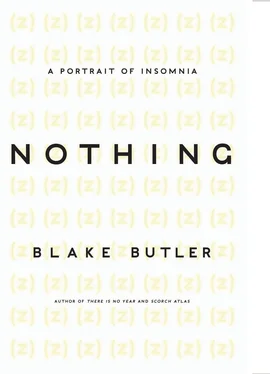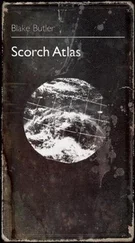In addition to the pillow most nights I sleep with an extra blanket tucked in around my head. First it was the white and yellow baby blanket my mother sewed for me while I was building up inside her, adorned with alphabet letters I promptly ripped off as a young child. I managed to grow so attached to having it there pressed at my ear holes and against my cheeks that I used it most every night until I was twenty-five or twenty-six, clinging to the sound I’d worn into it, all that rub and spit, at which point the thing had been rubbed and rolled and wadded so hard and long and with such heat from my cranium and face that half of it had disintegrated. Its skeleton is sad — a collage of ragged threads and enormous holes, no doubt a colony of sick cells. Now I use another blanket, another my mother made for me, this time out of old shirts I used to wear. Perhaps in hotels or other bedrooms this explains the sudden flatness of that space, the drift or supposition of lying down on something foreign, othered, cells shat into the threads not mine and seething dry. Regardless, the utility of having a whole other surface in addition to the pillow with which to manipulate the comfort of my skull has become vital to my sleep comfort — at home it is something I can’t imagine nodding off without — if ultimately a further form of complication, in that it allows me that much more optional leeway, and that many more angles and ways of wadding through which I can customize my resting skull, the beginning of a sliding slope of further and further want for self-optimization, to the point the self itself begins to blur, always making more.
As once the head is secure there is the body. There are the arms, the legs, the hips, the chest — and therein, for each sector, further minor flesh divisions — there are the wrists, the fingers, the feet, the toes, the penis (or what have you), the knees, and so on, each of their own, and shifting in connection to each other. Each element of the body, for me, must seem corrected, made right in its position on the night, the comfort curling on its surface and inside it as the time around the self nods on. The restless body, rolling, finding partial conditions, in continual correction, begins to feel simultaneously thicker and thinner, stuffed and hollow — like a wet but drying bar of soap, hard at the center, soft around the edges, mushy, comes off on your hands. The fidget begets more fidget. The wanting mind, inside the body, makes more bread. And again, again, again. So many nights I’ve wished I could remove one of my arms, their awkward context, that sprawl, become a body not a body, but a blob — it has not happened yet. Some of these caretaking elements, also, we imagine, can take care of themselves in simply lying down, getting it right — the way so many easy sleepers seem to out of pure instinct, or perhaps of never worrying at all. Most nights, though, in my dumb body, I find that the majority of the at-least-an-hour timeslot that usually kicks off my bed entry and winding down to nowhere is characterized by a constantly recursing wave of awareness of current or potential discomfort in my alignment, for each entity, and all at once.
For instance: feet. Usually I like feet to be allowed out a certain bit from the end of my covers. They should never feel constrained — never wrapped up inside the blanket, locked of rummaging access, which is also a general rule for how my body must be when winding down — not butted up against or tangled in or even pressing lightly against another plane, which includes my girlfriend, if I have one, or the absence therein, or the grain. My feet often also should not be out so far from the blanket that they are fully exposed to whatever presence or air is there unseen at the bed’s end inside the room, as then eventually I will end up feeling vulnerable or cold (this is all assuming the bedroom is an average, slightly cool temperature, around sixty-eight degrees, which is my optimum setting for sleeping, and when stirred from these preferences may or may not cause further error in various ways). Furthermore, the way the feet come into alignment with the end of the mattress (I am 6'2") and with the lower edge of the blanket (brushing, say, just above the ankle) should not feel unusual or confined — the configuration of blanket to flesh, as at the head, must fall nicely in certain lay and texture with my body, if only so that it is pleasant enough that I can then forget — the body must be forgotten — at least long enough that the arrangement ceases feeling as it did in first coming into it, or the blanket moves by further moving, or its context is otherwise disrupted, blamed, or deranged.
Replicate this obsession with each manipulable appendage across the body and what you’ve got here is a potentially overwhelming 3-D puzzle of the self—4-D if you want to count the constant inner monologue that usually accompanies it, the frustration, the grunt—5-D if you want to add on the awareness that what you’re doing during all this shifting and mental shitting is also a noisemaker barging into the potential comfort of those sharing your local space, who are also trying to find their own ways into sleep, the guilt and pressure of which some nights will hold me trying to hold still there in an acknowledged as not-perfect configuration, waiting slowly to find ways to suggest myself into better modes without stirring the bed, waiting, for instance, for that other person to shift herself or breathe or otherwise show she too isn’t fully gone, the prolonging of which only builds more and more inner frustration, which when finally the crust breaks and you make the impending shift regardless, as you have to do if you want to ever go, you do so with a simmered gusto, an extra compressed fury in your turn, which unfailingly seems to be just rough enough to stir the other person at last anyway, thus ruining the whole reason you stayed still so long at all—6-D if you even remotely begin to nod into the time you are eating off of your sleeping, and what else you could be doing, or what you’re supposed to do tomorrow, or so on—7-D if… — 8-D if… — and so the Rolodex compiles — soon at 15,000-D, just like that, amalgamated in one self.
More precisely than the fear of death, insomnia seems a hypersensitivity to the condition of being alive. For years the presence of sleep trouble in a body was held by science as an emotional, mental problem, a self-imposed roadblock in the night. Only after years of wonder, study, did the clearer effects of the state begin to become named, a hurt not only stuck in the moment of no nod off, but accumulated in the body overall. Personality traits including depression, extraversion, histrionic behavior, hysteria, hypochondria, hypomania, internalization, introversion, neuroticism, perfectionism, psychasthenia (inability to resist maladaptive thoughts), schizophrenia, and somatization (tendency to translate psychosocial stress into somatic stress) have all been shown to have clear links to insomnia.9 For many, though — the self-tortured, in rooms set within their waking homes — these are only temporary lockouts. Transient insomnia, defined as spread over less than three days, is often the product of temporary error in the environment or body, new stressors in sickness or in sound. Chronic insomnia holds on longer, defined over arcs, in patterns, becoming maps. In order for the antisleep state to be considered chronic, by definition it should recur on average more than three nights every week, over a period of more than six months, and should affect the daytime procedure in manifest problems in energy, motivation, moods.
These characteristics are as well relative to the subject’s own needs and inset criteria for what is needed to be “well rested.” One body might need only five hours to feel fully made new, while someone else might need nine. All factors are known to change over a lifetime, as the cells and information in the body shift and wrinkle and bend in. Problem sleepers often interpret their rest conditions to be more severe than recorded sleep times and depths may, to someone outside that skin, make them seem. In some self-perceived “insomniacs” there might be no sign of a disrupted state at all — and yet, in their mind and flesh, they feel arrested, turned out, scratched. In many instances, the effect is attributable to microsleeps, short periods spanning somewhere between a fraction of a second and up to thirty seconds, wherein the body cuts in and back out of a deep sleep due to exhaustion, a blink too short to quantify. In this way, though the person never experiences a full-blown, calculable sleep session, he or she does transgress the phases of consciousness, blurring the mind, allowing rest. Many claims to extensive insomnia are, then, not only questionable, but perhaps even delusional. It becomes difficult to say.
Читать дальше












